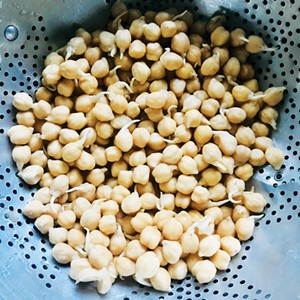My year working as a chef in Oklahoma City is coming to a close. The restaurant that dominated my life for 60 hours a week had to shutter and furlough its staff three weeks ago, and my newly acquired free time is being spent downsizing my belongings and packing for a new life living in a school bus.
In anticipation of my move and upcoming travels, I've been stocking the cabinets of my bus with nonperishable dry and canned goods, so even before the pandemic hit middle America I'd already stockpiled plenty of dry beans. Now I'm hearing that grocery stores and online retailers can't keep up with the demand for dry beans. The Napa Valley's premier heirloom bean purveyor Rancho Gorda has been overwhelmed by all the orders coming in.
The rising interest in bean cookery parallels the recent trend away from consuming animal protein and the shift towards a predominantly "plant-based" or "plant-forward" diet. Beans and other legumes are a healthful addition to our diet and provide protein, fiber, iron and antioxidants. In one seven-year study, legume consumption was the most important predictor of survival in people aged 70 and older. People who consume beans regularly have a decreased chance of having a heart attack. Some studies have shown that beans act as antioxidants and anti-inflammatory agents which could reduce the risk of cancer. Beans can help stabilize blood glucose levels and may even prevent diabetes. Research has shown a variety of beans, especially black beans, enhance gut health by improving intestinal barrier function and increasing the number of beneficial bacteria. Beans are high in fiber and feed the healthful gut bacteria colonies.
I'm often asked why I prefer cooking with dry beans versus canned. Dry beans are cheaper but require a bit of effort and planning. They must be picked over, rinsed, often presoaked and cooked for a considerable length of time. Presoaking and long-cooking might not be practical for a weeknight meal after a day at work but right now many of us aren't working anyway. Canned beans are more convenient: they are already perfectly cooked and just need to be rewarmed, but I worry about the harmful effects of BPA, BPS and BPF in the lining of cans. Canned beans also contain food additives and often have high sodium levels. I have canned beans in my pantry to use in a pinch, but I prefer dry beans whenever practical.
Beans have a bad reputation for causing flatulence. The reason beans cause gas is that they contain oligosaccharides that can't be fully broken down by our small intestines because we lack the necessary enzymes. Oligosaccharides pass undigested all the way into our large intestine where they are finally broken down and fermented by our gut bacteria, causing gas. If you suddenly increase the amount of beans into your diet, you can expect to experience increased flatulence. If beans remain a regular part of your diet you can expect gas levels to eventually decrease.
How beans are prepared can influence their gas-producing characteristics. Researchers in India found that soaking beans for 12 hours in plain water and discarding the soaking water reduced the gas-producing substances, though many cooks feel that in doing so you are pouring flavor and nutrients down the sink. Adding dry kombu to the cooking liquid, a common practice among Asian cultures, also helps decrease flatulence. My personal experience suggests that sprouting dry beans before cooking makes them easier to digest and reduces flatulence. Sprouting increases the bioavailability of vitamins and minerals. Sprouting also increases protein availability while decreasing carbohydrate levels. A bonus is the effect of sprouting on flavor. As an experiment I prepared two batches of cooked chickpeas. One batch was soaked overnight and cooked until tender. The second batch was soaked overnight and allowed to sprout for three days before cooking. My wife's assessment: "I could not get over the difference in taste between soaked vs. sprouted chickpeas for recipes. While the soaked were perfectly fine and tasty, nothing compares with the flavor of sprouted chickpeas. I could just eat them plain out of the bowl without any seasoning."
According to Steve Sando, the founder of Rancho Gordo and author of Heirloom Beans: Recipes from Rancho Gordo: "There isn't one single best method of cooking beans. When you're in a hurry, you may want to use a pressure cooker. On a leisurely, rainy Sunday, you might want to put a clay pot full of beans in the fireplace. At the most basic, you want to simmer the beans in the pot until they are soft. Soaking can speed up the process, and vegetable broth or chicken stock will make the beans more flavorful – it's really that simple."
Basic dry bean cookery – the slow way
Soak dry beans overnight in cold water.
Drain beans into a colander and rinse.
Rinse the beans at least three times a day until they begin to sprout. Look for quarter-inch tails. This may take two or three days, depending on the variety and age of the beans.
Using the pot you're going to cook the beans in, saute some onion and garlic in olive oil until soft. (For the omnivore version: Fry some diced bacon first, followed by onions and garlic.)
Add the beans to the pot and cover with 2 inches of water. Add a 4-inch piece of dry kombu to the pot. Stir and bring to a boil.
Boil the beans for 10 minutes, then reduce to a simmer.
(Total cooking time will vary based on the age and variety of the beans. Beans that have been harvested less than a year ago will cook fast. Older beans will have lost moisture content and require a longer cooking time.)
After an hour, periodically taste the beans. They should start feeling soft and tender. When you think they are close, sample five beans. If all five are not tender, continue cooking and continue to sample until all five beans pass the test. Discard the kombu and season to taste with salt and pepper.
The beans can be made into a standalone soup or added to a stew or stir-fry. I sometimes puree half the beans to make a thick broth and add the remaining beans for texture.
The cooked beans can also be cooled and used in a salad or pureed for a dip.
The cooked beans and their cooking liquid can be refrigerated for a week or frozen for several months.
Dr. Chef Peter is hoping that everyone is staying safe and using this time of self-isolation to become a better home cook. His best advice: Get out of your pajama bottoms or sweat pants every so often and make sure your jeans still fit!


















